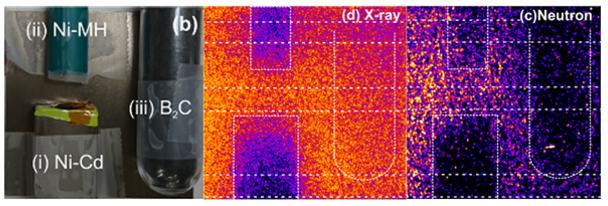Fetching the snapshots of systems and processes at accurate time points is key to research and development in several sectors, including material science, biology and engineering.
 The results of “snap shot” radiography using laser-induced neutrons and X-rays simultaneously. (Left) Photograph of the samples: Nickel metal hydride battery (Ni-MH), nickel cadmium battery (Ni-Cd), and boron carbide powder (B2C). (Center) X-ray radiography, where B2C is transparent to X-rays. (Right) Neutron radiography. The Ni-Cd can be distinguished from the Ni-MH based on the darkness of the shadow. In addition, low transmittance was observed for B2C. These results highlight the advantage of neutrons, which can identify materials that are transparent to X-rays. Image Credit: © 2021 A. Yogo et al., Applied Physics Express.
The results of “snap shot” radiography using laser-induced neutrons and X-rays simultaneously. (Left) Photograph of the samples: Nickel metal hydride battery (Ni-MH), nickel cadmium battery (Ni-Cd), and boron carbide powder (B2C). (Center) X-ray radiography, where B2C is transparent to X-rays. (Right) Neutron radiography. The Ni-Cd can be distinguished from the Ni-MH based on the darkness of the shadow. In addition, low transmittance was observed for B2C. These results highlight the advantage of neutrons, which can identify materials that are transparent to X-rays. Image Credit: © 2021 A. Yogo et al., Applied Physics Express.
One way of obtaining such information is to fire a neutron beam at a material. However, this method needs nuclear reactors and exclusive facilities. Scientists at Osaka University have presented a laser-driven technique of simultaneously producing neutrons and X-rays. The study results were published in the journal Applied Physics Express.
Analyzing a system without damaging it is highly beneficial when studying different structures. A method to achieve this is to aim the light, ionizing radiation or particles at the target material and observe how they interact with the target.
Neutrons, specifically low-energy neutrons, are excellent particles for this process due to their potential interaction capability with different nuclei, including hydrogen. Yet, neutron generation can demand specialist facilities and cannot be accessed easily.
Systems that use lasers to produce neutrons are becoming familiar now due to their compactness and the ability to generate short bursts of neutrons, as well as the ability to produce X-rays simultaneously.
Researchers at Osaka University have developed a laser-powered neutron source that measures just about the size of a fingertip and has the ability to produce a lot of fast neutrons in very short bursts. The neutrons are then decelerated by a moderator to make them ideal for imaging.
We were able to generate a high neutron density — higher than is found in some stars — which means we could acquire the information needed very rapidly. X-rays were also produced at the same time, so the system can offer two complimentary techniques in one.
Akifumi Yogo, Study Corresponding Author and Associate Professor, Osaka University
The neutrons were produced by switching a laser on and off. Such control over the neutron source renders the system safer than earlier alternatives.
Using their method, the researchers demonstrated that boron carbide, which could not be imaged with X-rays, was detected with the help of neutrons. Furthermore, they analyzed toxic elements in a typical battery through a non-destructive procedure. Thus, they were able to detect the presence of cadmium using neutrons.
The rapid neutron burst we were able to achieve with our system will provide imaging information for very rapid processes. For example, we believe events such as fuel injection in engines and bubble collapse in fast jets could be observed, which would provide valuable information for research in many industries.
Akifumi Yogo, Study Corresponding Author and Associate Professor, Osaka University